Travel Through Peru on a Harley-Davidson
By Peter & Kay Forwood
Peru on a Harley (30/11/02 - 21/12/02)
Distance 3451 km (315149 km to 318600 km)
This is part of the ninth section of our around the
world trip.
Complete Trip Overview & Map
Coming from Bolivia
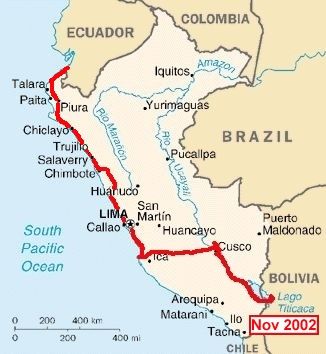 30/11/02 We arrived as the border opened, an hour behind
Bolivian time, 8.00 am. Easy immigration and customs but a firm request for
money from the police, rejected politely. Puno and a great tour to Sillustani,
a pre Inca, stone tower burial grounds. We joined the Gringo Trail from Uyuni
a few weeks ago and will probably stick with it till Lima. It comes with
the good and bad. A loss of individuality but good tours and facilities.
A chance to meet other travellers but mingling in are the dreadlocked gone
local bunch. More touts, beggars and dual prices (local and higher tourist)
but things to see that bring tourists.
30/11/02 We arrived as the border opened, an hour behind
Bolivian time, 8.00 am. Easy immigration and customs but a firm request for
money from the police, rejected politely. Puno and a great tour to Sillustani,
a pre Inca, stone tower burial grounds. We joined the Gringo Trail from Uyuni
a few weeks ago and will probably stick with it till Lima. It comes with
the good and bad. A loss of individuality but good tours and facilities.
A chance to meet other travellers but mingling in are the dreadlocked gone
local bunch. More touts, beggars and dual prices (local and higher tourist)
but things to see that bring tourists.
1/12/02 The Uros people started living on the totora reeds,
which grow in the large bay of Puno, to avoid persecution. They developed
techniques for creating floating reed beds, boats, housing and even eating
the succulent reed base. Tourism and modern life has however overtaken them.
The floating reed islands are now only maintained for tourists, the inhabitants
living in more modern stilt houses on reclaimed islands.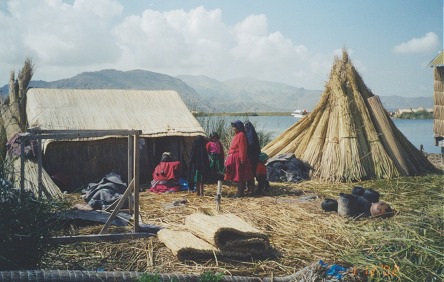 Whilst not authentic for their current lifestyle the old culture is maintained
through tourism. Our tour boat, 30 passengers, one of many, visited one of
the floating islands, two metres thick in reeds and spongy to walk on, bought
some souvenirs and left the people alone for the rest of the day. The tour
operators have obviously been aware of western values regarding begging and
asking for payment for photos, neither occurred whilst we were on the islands.
Whilst not authentic for their current lifestyle the old culture is maintained
through tourism. Our tour boat, 30 passengers, one of many, visited one of
the floating islands, two metres thick in reeds and spongy to walk on, bought
some souvenirs and left the people alone for the rest of the day. The tour
operators have obviously been aware of western values regarding begging and
asking for payment for photos, neither occurred whilst we were on the islands.
2/12/02 The shop where the motorcycle was parked didn't
open till 8 am so it was later leaving than anticipated and we needed to dodge
growing thunderstorms on the way to Cusco. We stopped for lunch to let one
pass to find the only meal available was the local delicacy of baked guinea
pig. Stuffed, with head and feet still attached this small animal was very
succulent served with one of the hundreds of potato varieties native to the
area. Guinea pig was such a delicacy in Inca times that the Last Supper painting
in the Cusco Cathedral depicts the thirteen around a dish of guinea pig.
The dry altiplano slowly became greener as we descended through more terraced
crops on the steep slopes.
3/12/02 South America's oldest city and the capital of
the Inca Empire, Cusco still retains portions of its past histories. Despite
the Spaniards tearing down Inca walls to make room for their magnificent churches
the amazingly hewn and close fitting stones of the Inca's remain in many
foundations and up to the first floor in the buildings of the narrow lane
ways. We collected our tourist card (bulk entry to museums and ruins) and
were totally impressed with every aspect of the city. Inca walls or colonial
buildings, no energy or expense was spared in their construction.
4/12/02 The city centre of Plaza de Armas is surrounded
by shops and second floor restaurants, a great way to get away from the hassles
of postcard, shoeshine and trinket sellers that won't allow you any peace
to watch the goings on in the streets. A couple more museums and the main
Inca temple of Coricancha, supposed to have been lined with 700 x 2 kg gold
sheets, when the Spaniards arrived. We walked up the hilly streets behind
the town and explored narrow lanes.
5/12/02 The prices to visit Machu Picchu have escalated
sharply in the last few years with walking the Inca Trail at over $US 200.00.
Entry fees are $US 20.00, and the cheapest train from Cusco $US 35.00 return,
rising to $US 73.00 for the tourist train. Westerners are no longer allowed
to walk the trail without a guide nor take the local train. It all adds up
to milking the tourist cow which is OK providing the money is put back to
preserving the ruins and not increasing political wealth. Cusco was a planned
city of the Incas in the shape of a Puma, with its head to the north. Here
ruins of the Pumas teeth lie, with stones as big as 30 tons still remaining
in the staggered tooth filled jaw. We visited this site and a few others
in the sacred valley on our way to Ollantaytambo, 100 km from Cusco and the
cheapest train to Machu Picchu at $US 20.00 return. The most impressive ruins
have to be at Pisac.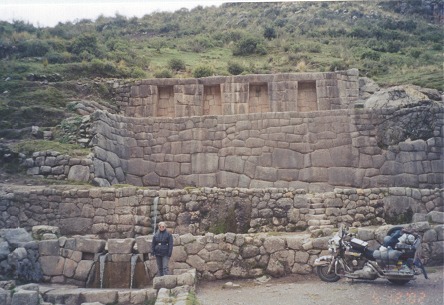 Set on a mountain peninsula and surrounded by cliffs or fortified walls four
villages terraced magnificent fields into the hillside. Many of the tracks
from village to village hugged the cliff walls with even a tunnel dug at
one point. The temple complex had the beautiful close cut and fitted stones
the Inca's were so famous for. We also visited the Ollantaytambo ruins, with
the largest carved stones, the temple incomplete, halted by the Spanish invasion.
The motorcycle stored at an auberge, right at the train station and we caught
the 8 pm train to Aguas Calientes (our only choice for the cheap train).
Set on a mountain peninsula and surrounded by cliffs or fortified walls four
villages terraced magnificent fields into the hillside. Many of the tracks
from village to village hugged the cliff walls with even a tunnel dug at
one point. The temple complex had the beautiful close cut and fitted stones
the Inca's were so famous for. We also visited the Ollantaytambo ruins, with
the largest carved stones, the temple incomplete, halted by the Spanish invasion.
The motorcycle stored at an auberge, right at the train station and we caught
the 8 pm train to Aguas Calientes (our only choice for the cheap train).
6/12/02 Aguas Calientes is the end of the train track for
tourists. Nestled in a valley between towering peaks and a raging river alongside
we had arrived from dry land to almost rain forest on the night train. Here
hundreds of tourists daily dodge the handicraft stalls between train and
bus stations before the switch back ride to Machu Picchu. Backpackers fill
the town's booming hotels and restaurants forced by train prices to stay
two nights here. Away from the main street the locals live in shoddily built
concrete and tin houses. The place has the feel of a frontier mining town,
some having made the money, others living in squalor still hoping. We caught
the bus up ($US 4.50) and were in awe of the sight, overlooking Machu Picchu
before the tourist trains arrived, almost empty of people. The ruins themselves
no more stunning than others we have seen but the setting, in the mountains,
atop a mountain itself, cliffs to the river below, in cloudy forests to me
the main attraction.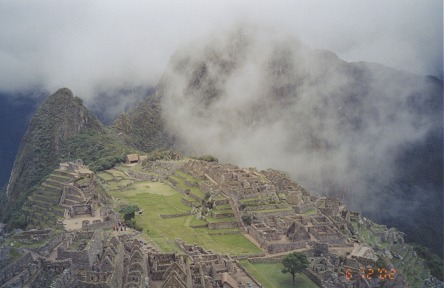 We sat for hours just watching the morning cloud blow through the ruins,
finally clearing. We watched the tour groups arrive and hustled by their guides
wander the site and eventually the noisy local school groups descended
on us so we left to walk down the mountain back to Aguas Calientes.
We sat for hours just watching the morning cloud blow through the ruins,
finally clearing. We watched the tour groups arrive and hustled by their guides
wander the site and eventually the noisy local school groups descended
on us so we left to walk down the mountain back to Aguas Calientes.
7/12/02 Again the only cheap train option had us leaving
at 6 am and arriving to collect the motorcycle at 8 am. We had intentionally
made Machu Picchu our finale for the Inca Ruins, and now headed towards Abancay
and off the highlands towards the coast. This newly asphalted road, totally
sealed, (except finishing roadworks of 30 km of dirt after Abancay) winds
and twists over three high mountain passes down into hot valleys on its way
to Puquio where after 550 km we stayed the night. The third pass was more
a high altitude plateau where only llama and the hardiest people live. It
was late into dusk as we crossed and the temperature dropped to 4 degrees,
cold we arrived in Puquio.
8/12/02 Down and up over another mountain pass with the
surrounding landscape slowly turning to desert before we reached the coastal
plains at Nazca. Here we met two German women motorcycle travellers on a
BMW and an Africa Twin, Susi Jungkeit and Claudy Lendle travelling the length
of the Americas and heading south.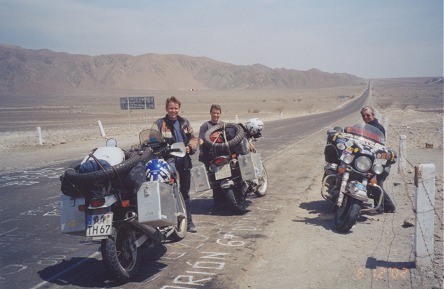 They had just climbed the tower to view the Nazca lines. Spread out across
the stony desert these lines drawn by removing the darker stones are believed
to have been made about 2000 years ago. They depict many animals up to 200
metres in size. They were part of the speculation that UFO's had visited earth
being best viewed from the air. We climbed the tower to view two figures
of a bird and moved onto Pisco for the night after a roadside oil change.
They had just climbed the tower to view the Nazca lines. Spread out across
the stony desert these lines drawn by removing the darker stones are believed
to have been made about 2000 years ago. They depict many animals up to 200
metres in size. They were part of the speculation that UFO's had visited earth
being best viewed from the air. We climbed the tower to view two figures
of a bird and moved onto Pisco for the night after a roadside oil change.
9/12/02 Out of the mountains and back to the coast. The
weather warm and dry with afternoon sea breeze. No problems breathing and
more energy it seems odd we want a rest. A short ride along the coast past
the offshore islands of sea lion colonies and birds nesting, their guano used
here for thousands of years as fertilizer. Past the more modern fish oil
and fish protein processing factories drying the fish and filling the air
with that strong fish market stench. There is no greenery, just the ocean
running into the desert but there is some appeal between the fish boats and
fish restaurants.
10/12/02 More motorcycle travellers heading south as we
go north. We always seem to be heading against the flow. Mika, who we had
met in Turkey three years ago and he is still travelling, Mark an Australian
and a Danish couple plying the well worn route from North to South America.
I think that makes 18 westerners on bikes in the last month, only one heading
north. Meeting someone a second time on the road, particularly 3 years apart
and both still travelling is something unusual and a lot to talk about between
us.
11/12/02 Just rested over a few beers and a bit of planning
for the Caribbean trip.
12/12/02 We had been unable to get a Dunlop tyre in Chile
or Bolivia and had bought and carried an emergency inferior brand in case
ours hadn't lasted to Lima. But by going slowly and having it well inflated
we nursed the old one through. Today we collected a new one from the H-D dealer
and in typical Peruvian style we were first quoted $US 190.00 but thanks
to Luis (from the Horizons Community) we knew they were available elsewhere
at $US 150.00 and the price was immediately reduced. Dunlop will reimburse
us for the expense later. Not ready for the 8 million people of Lima and
their pollution we fitted the new tyre and moved north. The region around
Lima is famous for its sea fog and mixed with a big city's pollution the
air was unpleasant to breathe having a depressing closed in effect after
the clarity of the mountains we have just been through. More deserts to the
north on the Panamericana and looking forward to getting back onto minor
roads.
13/12/02 It was not hard to work out that all the chicken
meat in Peru comes from the desert sandunes. Row upon row of roughly constructed
cloth walls and roofed houses grow this staple meat. We headed back up into
the mountains to Huaraz and whilst the scenery was beautiful it was not stunning
like we have seen elsewhere recently. I have not been feeling well for the
last two weeks, nothing specific, just run down, a virus or stomach problem,
and not feeling like sightseeing we moved on to Yungay and rested for 15
hours. It was here in a 1970 earthquake every member of the town's 18,000
was killed in a landslide. The new town was built nearby.
14/12/02 Still not feeling well we headed out early through
a few small mountain towns living off the higher rainfall and fertile valleys.
These towns all over Peru have lost the appeal of rural villages with traditional
houses and are now concrete and terracotta brick with reo steel sticking out
of the top floor giving the whole place an untidy, unfinished look. The rubbish
in the street doesn't add to their appeal. The road turned to mostly single
lane dirt for about the last 150 km to the coast at Santa. But the scenery
along the road made this detour worthwhile. We followed the river from its
source to its mouth. From crystal clarity carving its way through two stunning
gorges as we weaved through dozens of single lane tunnels along the disused
railway track, now road. A hydro scheme slows the river for a while and just
as it gets to full strength Peru's environmental laws come to full light
as the river turns black after washing the dirt in surrounding mines. Still
it doesn't deter the locals from using the polluted water for their irrigated
vegetables and sugar cane farms. I wonder why we feel sick. A magnificent
river in a stunning setting destroyed near its mouth by uncontrolled mining.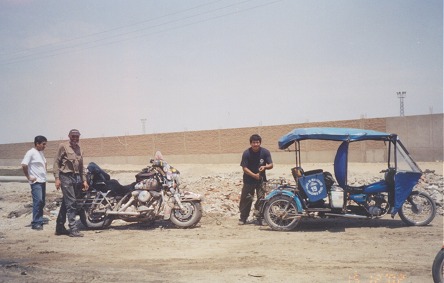
15/12/02 Yesterday evening we were looking for a beach
place to hang out for a couple of days and by coincidence met Todd Peer and
Hugh Caldwell, heading south on their KLR and Suzuki 650 motorcycles, right
opposite the turn off to Chicama. Our hotel overlooks the beach and its series
of left break waves, supposed to be the longest in the world. All three bikes
took the short cut off the headland in front of the hotel onto the beach
for a hard packed sand ride but as with yesterday's environmental experience
the fish oil and meal processing plant at the southern end pumps its effluent
straight back into the ocean and billows its fishy stinking smells into the
atmosphere. We rode a few km's to the north but between the smell, the dirty
sea water and the dozen or more dead dolphins on the beach being devoured
by vultures the ride became unpleasant quickly. Adding more to the unpleasantness
was when leaving the beach we became bogged in the sand and our tired worn
drive belt broke, leaving us stranded in the smell. We tried to fix the belt
in the sand but gave up and organized a push out and a tow up to our hotel
behind a 3 wheeler motorcycle used here as people movers. Luckily the wind
almost always blows S-N so our end of the beach is cleaner with fresh air.
16/12/02 It seems we used the wrong anti seize on the swing
arm bolt in Buenos Aires just three months ago and it has now rusted solid
to the bushes. The whole day was spent coaxing it out with a sledge hammer,
tapping it back and forth applying lubricant.
17/12/02 With the swing arm bolt finally loose it was a
normal belt change taking the morning. The afternoon was spent resting, as
will tomorrow as we haven't yet had the rest day we came here for.
18/12/02 A rest day with a few "just living jobs"
19/12/02 The next surfing beach north seems to be at Mancora,
560 km. More desert with irrigation fields from mountain streams, Not much
traffic and good roads got us there by 3 pm. It seems if you want your house
painted just wait for the next election and one or the other political party
will do it for you together with their candidates picture and party slogan.
All you need do then is cover it with one or more coats after the election.
The problem is the final coat doesn't seem to happen so almost every house
remains a billboard to a successful or failed candidate.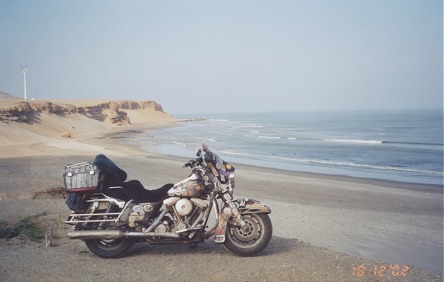
20/12/02 Mancora seems to be a holiday destination for
the well financed Lima'ites plus a few surfers and fewer westerners. The road
north and south runs along the beach and strung out along it are dozens of
restaurants and hostals. The season hasn't yet started (Jan-Mar) so we enjoyed
that pre season enthusiasm of the locals preparing for the onslaught of loose
spending tourists. A much better time to visit than the end of the season
when everyone is tired and the money is in the bank, The waves rolled in
but the water still looked dirty to us.
21/12/02 We had decided to spend Christmas in Quito, Ecuador
and New Years Eve in Bogota, Colombia so we need to move quickly, leaving
Peru at Aguas Verde, easy departure, easy paperwork, however the thriving
cross border town meant immigration 5 km before the border but aduana (customs)
right at the border.
Move with us to Ecuador
 30/11/02 We arrived as the border opened, an hour behind
Bolivian time, 8.00 am. Easy immigration and customs but a firm request for
money from the police, rejected politely. Puno and a great tour to Sillustani,
a pre Inca, stone tower burial grounds. We joined the Gringo Trail from Uyuni
a few weeks ago and will probably stick with it till Lima. It comes with
the good and bad. A loss of individuality but good tours and facilities.
A chance to meet other travellers but mingling in are the dreadlocked gone
local bunch. More touts, beggars and dual prices (local and higher tourist)
but things to see that bring tourists.
30/11/02 We arrived as the border opened, an hour behind
Bolivian time, 8.00 am. Easy immigration and customs but a firm request for
money from the police, rejected politely. Puno and a great tour to Sillustani,
a pre Inca, stone tower burial grounds. We joined the Gringo Trail from Uyuni
a few weeks ago and will probably stick with it till Lima. It comes with
the good and bad. A loss of individuality but good tours and facilities.
A chance to meet other travellers but mingling in are the dreadlocked gone
local bunch. More touts, beggars and dual prices (local and higher tourist)
but things to see that bring tourists.  Whilst not authentic for their current lifestyle the old culture is maintained
through tourism. Our tour boat, 30 passengers, one of many, visited one of
the floating islands, two metres thick in reeds and spongy to walk on, bought
some souvenirs and left the people alone for the rest of the day. The tour
operators have obviously been aware of western values regarding begging and
asking for payment for photos, neither occurred whilst we were on the islands.
Whilst not authentic for their current lifestyle the old culture is maintained
through tourism. Our tour boat, 30 passengers, one of many, visited one of
the floating islands, two metres thick in reeds and spongy to walk on, bought
some souvenirs and left the people alone for the rest of the day. The tour
operators have obviously been aware of western values regarding begging and
asking for payment for photos, neither occurred whilst we were on the islands.

 Set on a mountain peninsula and surrounded by cliffs or fortified walls four
villages terraced magnificent fields into the hillside. Many of the tracks
from village to village hugged the cliff walls with even a tunnel dug at
one point. The temple complex had the beautiful close cut and fitted stones
the Inca's were so famous for. We also visited the Ollantaytambo ruins, with
the largest carved stones, the temple incomplete, halted by the Spanish invasion.
The motorcycle stored at an auberge, right at the train station and we caught
the 8 pm train to Aguas Calientes (our only choice for the cheap train).
Set on a mountain peninsula and surrounded by cliffs or fortified walls four
villages terraced magnificent fields into the hillside. Many of the tracks
from village to village hugged the cliff walls with even a tunnel dug at
one point. The temple complex had the beautiful close cut and fitted stones
the Inca's were so famous for. We also visited the Ollantaytambo ruins, with
the largest carved stones, the temple incomplete, halted by the Spanish invasion.
The motorcycle stored at an auberge, right at the train station and we caught
the 8 pm train to Aguas Calientes (our only choice for the cheap train).
 We sat for hours just watching the morning cloud blow through the ruins,
finally clearing. We watched the tour groups arrive and hustled by their guides
wander the site and eventually the noisy local school groups descended
on us so we left to walk down the mountain back to Aguas Calientes.
We sat for hours just watching the morning cloud blow through the ruins,
finally clearing. We watched the tour groups arrive and hustled by their guides
wander the site and eventually the noisy local school groups descended
on us so we left to walk down the mountain back to Aguas Calientes.
 They had just climbed the tower to view the Nazca lines. Spread out across
the stony desert these lines drawn by removing the darker stones are believed
to have been made about 2000 years ago. They depict many animals up to 200
metres in size. They were part of the speculation that UFO's had visited earth
being best viewed from the air. We climbed the tower to view two figures
of a bird and moved onto Pisco for the night after a roadside oil change.
They had just climbed the tower to view the Nazca lines. Spread out across
the stony desert these lines drawn by removing the darker stones are believed
to have been made about 2000 years ago. They depict many animals up to 200
metres in size. They were part of the speculation that UFO's had visited earth
being best viewed from the air. We climbed the tower to view two figures
of a bird and moved onto Pisco for the night after a roadside oil change.

